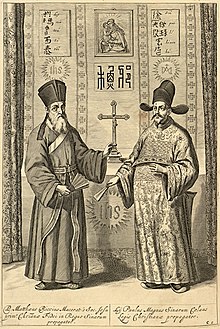Xu Guangqi

Xu Guangqi ( Chinese 徐光啟 / 徐光启 , Pinyin Xú Guāngqǐ ; born April 24, 1562 in Shanghai ; † November 8, 1633 in Beijing ), also called Zixian ( 子 先 , Zǐxiān ), was a scholar and minister of the Ming Dynasty .
Life
Xu Guangqi was born in Shanghai into a family that had been damaged by Japanese pirates. He grew up in poor conditions, but received a solid school education from the age of 6 and step by step passed state official exams (1581: xiucai ; 1597: jieyuan ; 1604: jinshi ), which gave him a career in the highest positions in the empire up to the minister. As such, he put many of his ideas into practice.
Xu found the Catholic faith through the Italian Jesuit Father Ricci, who was active in China, and was baptized with the name Paul in 1603. Together with Ricci, he translated several Western texts into Chinese and Confucian texts into Latin. Along with Li Zhizao (1565–1630) and Yang Tingyun (1557–1627), he is one of the most famous converts in the country, who are called the "three pillars of the Christian religion in China" in reference to a passage from the Bible.
Between 1607 and 1610, Xu lived in Shanghai without a government office. During this time he began experiments to improve agriculture, which he was later able to translate into policy measures when he became minister.
Xu died in Beijing at the age of 71. The body was transferred to Shanghai . His grave in Guangqi Park has been on the list of monuments of the People's Republic of China since 1988 .
Xu's granddaughter Candida (1607–1680) supported the Jesuit Philippe Couplet (1623–1693) in founding churches in Jiangnan and was immortalized by him as a Christian lady in a biography.
Work and Legacy
Xu left a work of 130 volumes in which he expanded his research. Together with Ricci, he translated European writings, such as The Elements of Euclid , and revised the calendar. In his book Nong-zheng quan-shu ('Compendium of Agricultural Measures') he showed steps towards developing agriculture: fighting locusts, containing floods, reclamation, improved cultivation methods, including the introduction of the Philippine sweet potato, as well as water management and expansion of cotton growing. This work also had a great influence on the development of Japanese agricultural science by Miyazaki Yasusada .
literature
- Catherine Jami, Peter Engelfriet and Gregory Blue (ed.): Statecraft and intellectual renewal in late Ming China: the cross-cultural synthesis of Xu Guangqi (1562-1633) . Suffering a.]: Brill, 2001.
- David E. Mungello: Curious Land: Jesuit Accommodation and the Origins of Sinology . University of Hawaii Press, 1989.
- Needham, Joseph: Science and Civilization in China: Volume 3, Mathematics and the Sciences of the Heavens and the Earth . Cambridge [u. a.]: Cambridge University Press, 1979.
- Needham, Joseph: Science and Civilization in China: Volume 6, Biology and Biological Technology, Part 2: Agriculture . Cambridge [u. a.]: Cambridge University Press, 1986
- Übelhör, Monika: 'Hsü Kuang-ch'i (1562–1633) and his attitude to Christianity: A contribution to the intellectual history of the late Ming period', Oriens extremus 15, 1968, 191–257; 16, 1969, 41-74.
- Claudia von Collani : Xu Guangqi, Paul. In: Biographisch-Bibliographisches Kirchenlexikon (BBKL). Volume 14, Bautz, Herzberg 1998, ISBN 3-88309-073-5 , Sp. 281-284.
Remarks
- ↑ Galatians letter Gal 2.9 EU
- ^ Philippe Couplet: Historia nobilis feminæ Candidæ Hiu christianæ Sinensis ( Histoire d'une dame chrétienne de la Chine, Candide Hiu , Paris, Michallet 1688). See also Mungello (1989), pp. 254-256.
Web links
- John J. O'Connor, Edmund F. Robertson : Xu Guangqi. In: MacTutor History of Mathematics archive .
- dartmouth.edu: Hsü Kuang-ch'i
- Tomb of Xu Guangqi - English
| personal data | |
|---|---|
| SURNAME | Xu Guangqi |
| ALTERNATIVE NAMES | 徐光启 (Chinese); Hsü, Kuang-ch'i; Xu, Paul; Hsü, Paul; Xu, Wending; Siu, Paul; Tseu-Kwang-K'he |
| BRIEF DESCRIPTION | Scholar and minister of the Ming dynasty, important Catholic convert |
| DATE OF BIRTH | April 24, 1562 |
| PLACE OF BIRTH | Shanghai |
| DATE OF DEATH | November 8, 1633 |
| Place of death | Beijing |

